A short history of excavations and investigations in Babylon
by Georg Neumann
The beginnings: the time before Robert Koldewey
As early as the 12th century, travelers visited the ruins of Babylon for the first time, proving the authenticity of the former metropolis. Until the 17th century, however, the erroneous assumption persisted that the ziggurat of Aqr Quf (Dur Kurigalzu) was the famous Tower of Babel. Pietro della Valle (1586-1952), who visited the ruins in 1616, was the first to rectify this misinterpretation. He also undertook small scale excavations in the area of Nebuchadnezzar's so-called summer palace.
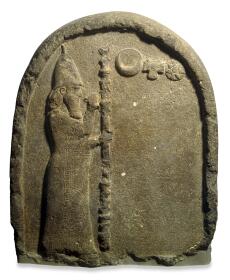
In the 1780s, the Abbot Joseph de Beauchamp (1752-1801) visited the ruins and participated in excavations undertaken by local farmers to quarry baked bricks. During these excavations he found glazed and some inscribed bricks, which he sent to Paris. As a result, the British East India Company wanted to acquire comparable pieces for their newly founded museum. The first inscription reached London in 1801 (the so-called “East India House Inscription”, now hosted at the British Museum). Subsequently, it was Claudius James Rich (1787-1821) who visited Babylon in 1811 with the aim to understand the topography of the site. He only undertook minor excavations, which he published in 1815 under the title "Memoir on the Ruins of Babylon". His most important find is certainly the stela of Nabonidus, which he sent to London, along with cylinder seals, cuneiform tablets and inscribed bricks. After his death in 1821 his widow sold his collection to the British Museum.
With the beginning decipherment of cuneiform writing by Georg Friedrich Grotefend in 1802, interest in the Ancient Near East and thus also in Babylon grew more and more. Thus, in 1830, Robert Mignan (1803-1852), a captain in the East India Company, conducted two excavations in the famous city. Twenty years later, in 1850, Austen Henry Layard (1817-1894) found numerous tombs containing, among other things, Aramaic Incantation Bowls. He also sent glazed bricks from Nebuchadnezzar's palace to the British Museum.

The first French excavations took place in 1852 under the direction of Fulgence Fresnel (1795-1855) and Jules Oppert (1825-1905) in the area of the royal castles (Kasr). During this work, the so-called Lion of Babylon was found, which is still exhibited in Babylon today. The finds from these excavations were to be sent to Paris in 1855, but the ship that had loaded the finds from Babylon and the Assyrian metropolis of Khorsabad sank in the Shatt al-Arab.
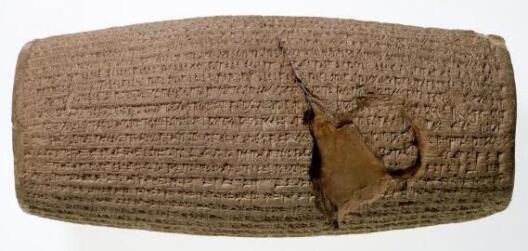
These excavations were followed in 1879 by Hormuzd Rassam (1826-1910), who dug mainly in the areas of the temples of the deities Ninmaḫ and Marduk. He excavated numerous cuneiform tablets. Probably his most important find was the so-called Cyrus Cylinder.
The German excavations in Babylon under Robert Koldewey (1899–1917)
An expedition to Mesopotamia by Eduard Sachau (1845-1930) and Robert Koldewey (1855-1925), financed by James Simon (1851-1932) in 1897/1898, aimed to identify potential sites for excavations. It was decided to excavate in Babylon, mainly supported by the 1899 founded German Oriental Society, the Royal Museums of Berlin and the German Emperor Wilhelm II (1859-1941).
The 18 years of excavation under the direction of the architect Robert Koldewey began on March 26, 1899, and ended, due to the First World War, on March 7, 1917. The work was interrupted only twice for longer periods from April 7 to June 23, 1905 due to negotiations with the Ottoman authorities, and from October 14, 1915 to January 2, 1916 because of the presence of Allied troops.
Between 1899 and 1917, excavations were carried out on the various hills of Babylon. The excavations in the Kasr area took place from 1899 to 1915. The most extensive excavations in that area were in the years 1900, 1903 and 1913. The excavations in the area of Amran and Ishin-Aswad took place primarily in the years 1900 and 1901. There the temples of Ninurta, of Išḫara, and parts of the Marduk temple and also private houses have been uncovered.
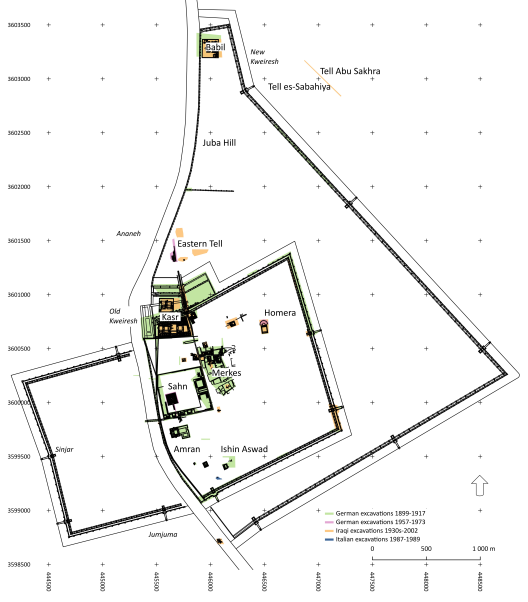
So-called search pits were dug, that indicated a widely spread urban settlement. From 1905 to 1912, Oscar Reuther was in charge of excavating in the Merkes area. Here, excavators uncovered the Ištar temple and individual residential areas. In some search pits, layers dating back even to the Old Babylonian period were reached due to temporarily lowered groundwater levels. In the Sahn area, work was carried out in 1901 and from 1908 to 1910, where excavations primarily focused on the Neo-Babylonian temple area. A Greek theater was uncovered in Homera in 1904, along with some Neo-Babylonian private houses.
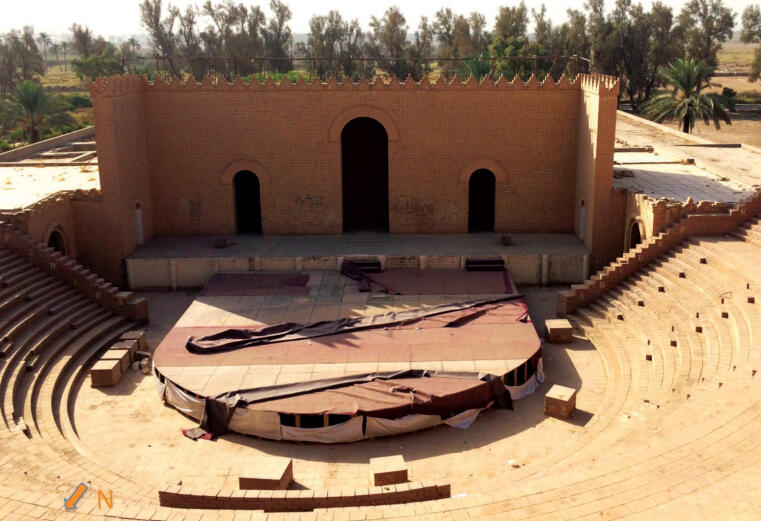
In addition to Robert Koldewey, who supervised the excavations, several archaeologists, architects and engineers worked on the site, some for several years. Because of World War I, the excavations came to an end on March 7, 1917.
| Name | Period of activity |
|---|---|
| Walter Andrae | 1899-1903 |
| Arnold Nöldeke | 1902-1908 |
| Hermann Baumgarten | 1902-1903 |
| Felix Langenegger | 1903-1905 |
| Julius Jordan | 1903 |
| Gottfried Buddensieg | 1904-1917 |
| Oscar Reuther | 1905-1912 |
| Friedrich Wetzel | 1907-1914 |
| Karl Müller | 1909-1912 |
| Adolf Neynaber | 1912-1913 |
| Friedrich Wachtsmuth | 1912-1915 |
| Walter Bünte | 1913-1914 |
| Paul Maresch | 1914 |
| Hugo Vollrath | 1914 |
| Hans Lührs | 1914 |
| Fritz Krischen | 1914 |
Later excavations and investigations in Babylon
After the German excavations under the direction of Robert Koldewey ended in 1917, plans were made to take up excavations again after the First World War as soon as possible. This was supported by Gertrude Lowthian Bell (1868-1926) who was, at that time, the Director of Antiquities in Iraq. Unfortunately, this never happened. Renewed German excavations on behalf of the German Archaeological Institute did not begin until 1957 and lasted until 1972. The goal was to clarify some of the questions raised by the older excavations of Koldewey and to examine in particular the later periods of Babylon (Hellenistic, Parthian, Sasanian and Arabic). This expedition was directed by Hansjörg Schmid and focused on the remains of the Etemenanki, the ziggurat of Babylon. From 1987 to 1989, excavations were carried out by an Italian team directed by Giovanni Bergamini. His excavations concentrated on the area of Ishin-Aswad. The campaigns aimed at solidifying our knowledge about the topography of one of the areas of the city beyond the city walls, the so-called Uraš Gate, situated in the southern part of Babylon, immediately east of one of its main gates. The project was originally designed to last five years, but unfortunately came to a halt because of the Second Gulf War.
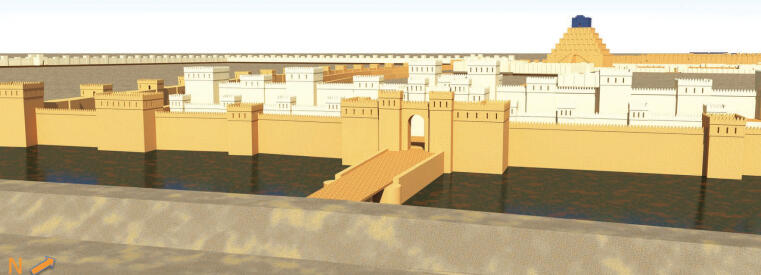
Extensive excavations have been carried out by the Iraqi Antiquities Authority since 1961, when the Ninmaḫ-Tempel was re-excavated and reconstructed (1961-1962). From 1979 to 1981 the Nabû temple in the Sahn area of Babylon have been unearthed and reconstructed. As part of the digging, directed by Moayed Saeed Damerji, parts of the Processional Way, the South Palace, the Ištar temple, the Marduk Gate, the theatre and Neo-Babylonian private houses were uncovered.
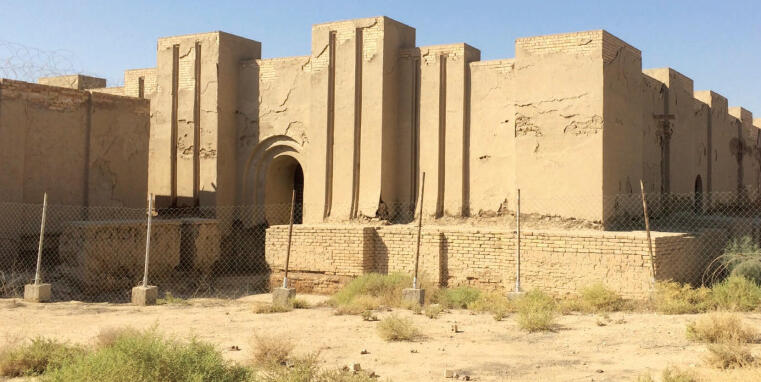
Further reading:
J. Marzahn – G. Schauerte (eds), Babylon Wahrheit. Munich, 2008.
O. Pedersén, Archive und Bibliotheken in Babylon. Die Tontafeln der Grabung Robert Koldeweys 1899-1917. Abhandlungen der Deutschen Orient-Gesellschaft 25, Saarbrücken, 2005.
O. Pedersén, Babylon. The Great City. Münster, 2021.
(Last update: 01/23/2024)
